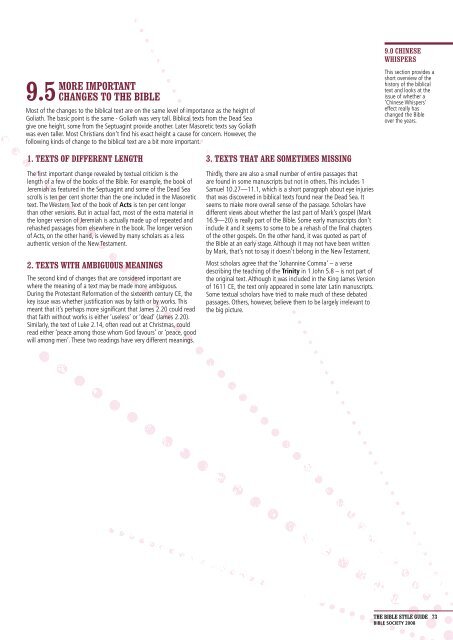BiBle STyle Guide - Get a Free Blog
BiBle STyle Guide - Get a Free Blog
BiBle STyle Guide - Get a Free Blog
You also want an ePaper? Increase the reach of your titles
YUMPU automatically turns print PDFs into web optimized ePapers that Google loves.
9.5<br />
more important<br />
changes to the <strong>BiBle</strong><br />
Most of the changes to the biblical text are on the same level of importance as the height of<br />
Goliath. The basic point is the same - Goliath was very tall. Biblical texts from the Dead Sea<br />
give one height, some from the Septuagint provide another. Later Masoretic texts say Goliath<br />
was even taller. Most Christians don’t find his exact height a cause for concern. However, the<br />
following kinds of change to the biblical text are a bit more important.<br />
1. texts of different length<br />
The first important change revealed by textual criticism is the<br />
length of a few of the books of the Bible. For example, the book of<br />
Jeremiah as featured in the Septuagint and some of the Dead Sea<br />
scrolls is ten per cent shorter than the one included in the Masoretic<br />
text. The Western Text of the book of Acts is ten per cent longer<br />
than other versions. But in actual fact, most of the extra material in<br />
the longer version of Jeremiah is actually made up of repeated and<br />
rehashed passages from elsewhere in the book. The longer version<br />
of Acts, on the other hand, is viewed by many scholars as a less<br />
authentic version of the New Testament.<br />
2. texts with amBigUoUs meanings<br />
The second kind of changes that are considered important are<br />
where the meaning of a text may be made more ambiguous.<br />
During the Protestant Reformation of the sixteenth century CE, the<br />
key issue was whether justification was by faith or by works. This<br />
meant that it’s perhaps more significant that James 2.20 could read<br />
that faith without works is either ‘useless’ or ‘dead’ (James 2.20).<br />
Similarly, the text of Luke 2.14, often read out at Christmas, could<br />
read either ‘peace among those whom God favours’ or ‘peace, good<br />
will among men’. These two readings have very different meanings.<br />
3. texts that are sometimes missing<br />
Thirdly, there are also a small number of entire passages that<br />
are found in some manuscripts but not in others. This includes 1<br />
Samuel 10.27—11.1, which is a short paragraph about eye injuries<br />
that was discovered in biblical texts found near the Dead Sea. It<br />
seems to make more overall sense of the passage. Scholars have<br />
different views about whether the last part of Mark’s gospel (Mark<br />
16.9—20) is really part of the Bible. Some early manuscripts don’t<br />
include it and it seems to some to be a rehash of the final chapters<br />
of the other gospels. On the other hand, it was quoted as part of<br />
the Bible at an early stage. Although it may not have been written<br />
by Mark, that’s not to say it doesn’t belong in the New Testament.<br />
Most scholars agree that the ‘Johannine Comma’ – a verse<br />
describing the teaching of the trinity in 1 John 5.8 – is not part of<br />
the original text. Although it was included in the King James Version<br />
of 1611 CE, the text only appeared in some later Latin manuscripts.<br />
Some textual scholars have tried to make much of these debated<br />
passages. Others, however, believe them to be largely irrelevant to<br />
the big picture.<br />
9.0 chineSe<br />
whiSperS<br />
This section provides a<br />
short overview of the<br />
history of the biblical<br />
text and looks at the<br />
issue of whether a<br />
‘Chinese Whispers’<br />
effect really has<br />
changed the Bible<br />
over the years.<br />
The <strong>BiBle</strong> <strong>STyle</strong> <strong>Guide</strong> 73<br />
bible society 2008


